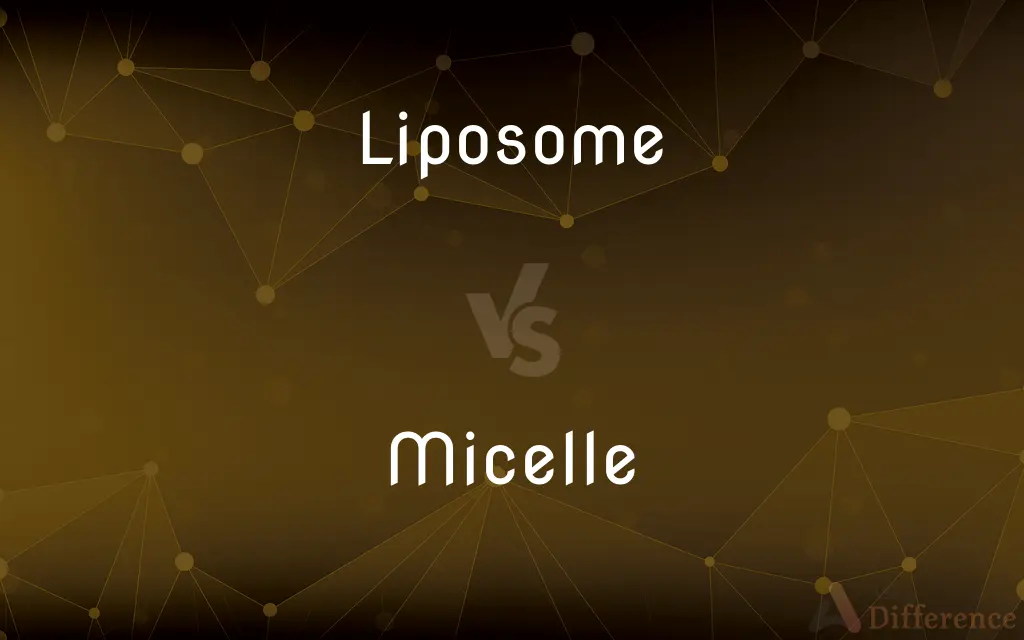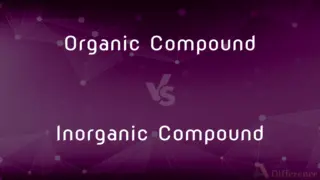Liposome vs. Micelle — What's the Difference?
Edited by Tayyaba Rehman — By Fiza Rafique — Updated on March 16, 2024
Liposomes are spherical vesicles with a bilayer membrane, used in drug delivery, while micelles are single-layered lipid molecules that form in water, aiding in solubilizing fats during digestion.

Difference Between Liposome and Micelle
Table of Contents
ADVERTISEMENT
Key Differences
Liposomes are characterized by their bilayer structure, which is made up of phospholipids. This structure allows them to encapsulate both water-soluble and fat-soluble substances, making them highly versatile for drug delivery and other applications in biotechnology and medicine. On the other hand, micelles form when amphiphilic molecules, like soaps and detergents, are introduced to water. Their structure consists of a hydrophobic core and a hydrophilic exterior, making them effective in solubilizing oily substances in aqueous environments.
The formation of liposomes involves the self-assembly of phospholipids in an aqueous environment, resulting in a vesicle with an aqueous core. This makes them suitable for encapsulating and delivering hydrophilic drugs. Whereas micelles form when the concentration of amphiphilic molecules reaches the critical micelle concentration (CMC), beyond which they aggregate with their hydrophobic tails inward and hydrophilic heads outward, effectively solubilizing hydrophobic compounds in water.
Liposomes can be designed to vary in size, from nanometers to micrometers, and can be engineered to have specific surface characteristics for targeted delivery. This customization allows for the precise control of drug release and distribution. In contrast, micelles are generally smaller and their size is more consistent, primarily dictated by the length of the amphiphilic molecules from which they form. Their simplicity and uniformity make them useful in applications like cleaning agents and in the formulation of some cosmetic products.
The stability of liposomes can be influenced by factors such as pH, temperature, and the presence of ions, which can affect their longevity and efficacy in drug delivery systems. Micelles, however, tend to be more robust in various environmental conditions but can disassemble when the concentration of the amphiphilic molecule falls below the CMC or when exposed to solvents that disrupt the hydrophobic interactions that hold the micelle together.
Comparison Chart
Structure
Bilayer membrane vesicles
Single-layered lipid molecules
ADVERTISEMENT
Core
Can encapsulate aqueous and lipid substances
Hydrophobic core
Formation
Self-assembly in aqueous environments
Formed at critical micelle concentration
Size
Variable, from nanometers to micrometers
Generally smaller and more uniform
Applications
Drug delivery, biotechnology
Solubilizing fats, detergents, cosmetics
Compare with Definitions
Liposome
Size and surface characteristics can be customized.
Specific liposome formulations target certain tissues.
Micelle
Forms when amphiphilic molecules reach CMC.
Adding soap to water results in micelle formation.
Liposome
Formed from phospholipids in water.
Liposomes mimic biological membranes, making them biocompatible.
Micelle
A colloidal aggregate with a hydrophobic core.
Micelles help in cleaning oil stains with detergents.
Liposome
A spherical vesicle with a bilayer membrane.
Liposomes are used to encapsulate drugs for targeted delivery.
Micelle
Generally smaller and more uniform than liposomes.
Micelle size is dictated by the length of its constituent molecules.
Liposome
Used in medicine and biotechnology.
Liposomal vaccines enhance immune responses.
Micelle
Used in detergents and cosmetics.
Micellar water is popular for removing makeup.
Liposome
Can carry both hydrophilic and hydrophobic substances.
Liposomes can deliver chemotherapy directly to cancer cells.
Micelle
Solubilizes hydrophobic compounds in water.
Micelles are crucial in absorbing fats in the digestive system.
Liposome
A liposome is a spherical vesicle having at least one lipid bilayer. The liposome can be used as a drug delivery vehicle for administration of nutrients and pharmaceutical drugs, such as lipid nanoparticles in mRNA vaccines, and DNA vaccines.
Micelle
A micelle () or micella () (plural micelles or micellae, respectively) is an aggregate (or supramolecular assembly) of surfactant molecules dispersed in a liquid, forming a colloidal suspension (also known as associated colloidal system). A typical micelle in water forms an aggregate with the hydrophilic "head" regions in contact with surrounding solvent, sequestering the hydrophobic single-tail regions in the micelle centre.
Liposome
A microscopic artificial vesicle consisting of an aqueous core enclosed in phospholipid molecules, used to convey vaccines, drugs, or other substances to target tissues.
Micelle
A submicroscopic aggregation of molecules, as a droplet in a colloidal system.
Liposome
(biochemistry) An aqueous compartment enclosed by a bimolecular membrane, typically of phospholipid; a lipid vesicle.
Micelle
An organic particle of colloidal size found in coal.
Liposome
An artificially made microscopic vesicle into which nucleic acids can be packaged; used in molecular biology as a transducing vector
Micelle
A coherent strand or structure in natural or synthetic fibers.
Micelle
A colloidal aggregate, in a simple geometric form, of a specific number of amphipathic molecules which forms at a well-defined concentration, called the critical micelle concentration
Micelle
An electrically charged particle built up from polymeric molecules or ions and occurring in certain colloidal electrolytic solutions like soaps and detergents
Common Curiosities
How do the sizes of liposomes and micelles compare?
Liposomes vary in size and can be much larger than micelles, which are generally smaller and more uniform.
Can liposomes encapsulate both water and fat-soluble substances?
Yes, liposomes can encapsulate both types of substances due to their bilayer structure.
At what concentration do micelles form?
Micelles form when the concentration of amphiphilic molecules in water reaches the critical micelle concentration (CMC).
What are liposomes used for?
Liposomes are primarily used for drug delivery and in various biotechnological applications.
Can the properties of liposomes be customized?
Yes, liposomes can be engineered to have specific sizes, surface characteristics, and functionalities.
Are liposomes or micelles more stable?
Stability varies depending on the conditions, but micelles are generally more robust in various environments compared to liposomes.
How do micelles aid in digestion?
Micelles help in the digestion and absorption of dietary fats by solubilizing them in the aqueous environment of the intestine.
What role do micelles play in cleaning products?
Micelles encapsulate and solubilize oily substances, making them effective in cleaning products like soaps and detergents.
What makes liposomes suitable for targeted drug delivery?
Their ability to encapsulate substances and be engineered with specific surface characteristics makes them suitable for targeted delivery.
What dictates the size of micelles?
The size of micelles is primarily dictated by the length of the amphiphilic molecules from which they form.
Are liposomes naturally occurring?
Liposomes can be synthetically made to mimic natural cellular membranes but are not naturally occurring entities.
How do environmental conditions affect liposomes?
Factors such as pH, temperature, and ion presence can affect the stability and integrity of liposomes.
How do micelles form?
Micelles form when amphiphilic molecules in water orient themselves with their hydrophobic tails inward and hydrophilic heads outward upon reaching CMC.
Can liposomes be used in vaccine delivery?
Yes, liposomes can be used to enhance the immune response in vaccine formulations.
What are the applications of micelles in cosmetics?
Micelles are used in cosmetic products like micellar water for their ability to remove oil and makeup from the skin.
Share Your Discovery

Previous Comparison
Boot vs. Kick
Next Comparison
Smoothe vs. SmoothenAuthor Spotlight
Written by
Fiza RafiqueFiza Rafique is a skilled content writer at AskDifference.com, where she meticulously refines and enhances written pieces. Drawing from her vast editorial expertise, Fiza ensures clarity, accuracy, and precision in every article. Passionate about language, she continually seeks to elevate the quality of content for readers worldwide.
Edited by
Tayyaba RehmanTayyaba Rehman is a distinguished writer, currently serving as a primary contributor to askdifference.com. As a researcher in semantics and etymology, Tayyaba's passion for the complexity of languages and their distinctions has found a perfect home on the platform. Tayyaba delves into the intricacies of language, distinguishing between commonly confused words and phrases, thereby providing clarity for readers worldwide.















































